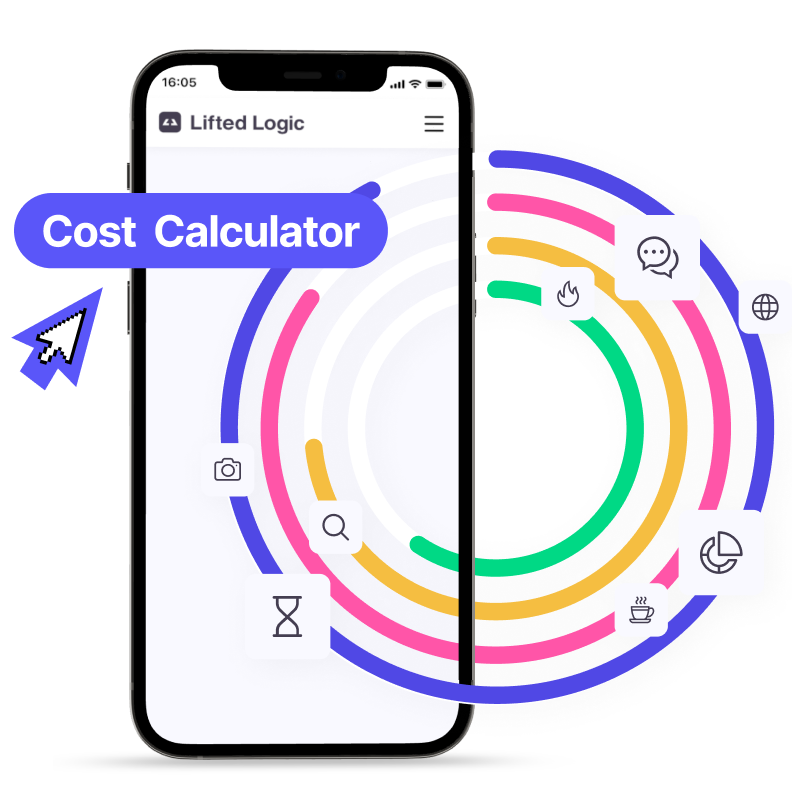Search engine optimization (SEO) takes time and effort, so maybe you’ve found yourself wondering, “Do I really have to do SEO on every page of my website?”
The short answer is no. Let’s talk about it.
Why do I need SEO in the first place?
Because we said so—just kidding! Because SEO helps search engines crawl and index website pages to learn what’s on them. After that, the search engine will rank your website based on what it finds.
Strong SEO will yield a higher ranking on search engine results pages (SERPs). Ranking well on SERPs is important because it’s the best way to help consumers find your awesome website.
An easily discoverable and well-trafficked website is valuable for many reasons. After all, that’s why Lifted Logic is in this business! But, that’s another blog for another time.
How do I know which pages need SEO?
Ultimately, pages need the components of SEO to show up on SERPs. If a page won’t benefit from showing up, then it doesn’t need SEO. So think about that page. What’s its purpose? How will your users interact with it?
Page Purpose
Pages can serve more than one purpose, and determining what’s what might sound intimidating at first. However, with a bit of practice, you’ll find your rhythm.
Take, for example, your website’s checkout page. It facilitates transactions which are crucial to your business. Importance, however, does not indicate a need for SEO.
Users on your checkout page are already on the hook. They learned what you do from some other source; now they want in on the action. But your checkout page is no use to a brand new user.
Users don’t purchase from a website they know nothing about. If they come across your checkout page first, they will quickly leave. We call that bouncing (and not the fun trampoline-kind). Your checkout page will not benefit from ranking well on SERPs, so it doesn’t need SEO.
Remember, you should always optimize pages for user experience (UX), which is not the same as SEO. Building a website is like fishing; you bait the hook with SEO, then reel them in with UX strategy.
User Intent
Considering the user’s intent is basically thinking about the purpose of the page from the perspective of the user. Also known as “search intent,” user intent is exactly what it sounds like.
A search engine’s purpose is to satisfy its user’s goal. The page that best answers the user’s question will rank highest on the SERP. Understanding user intent will revolutionize the way you create and publish content.
So, how does user intent inform whether a page needs SEO? It’s a lot like thinking about a page’s purpose, but with a twist. Rather than asking, “What do I want?” it asks, “What does the user want?”
If a person searches for “best digital marketing agency,” think about what type of results they are hoping to find. Hint: it’s not cat videos.

Using “best” means the user wants a resource to guide them through their decision. They might enjoy a blog comparing digital marketing agencies, or a pros and cons list about 1 agency. Understanding what “best” implies is what user intent is all about.
A blog about Lifted Logic’s incredible service and award-winning websites would satisfy this user’s search intent. Therefore, that blog would benefit from SEO. Conversely, pages like our contact form or cost analysis tool would not satisfy that user’s search intent.
Long story short, if a user isn’t searching for it, it does not need SEO. But it could probably still use a cat video 😸
What’s the difference between an SEO page and a non-SEO page?
If you’re still having trouble deciding if a page needs SEO, don’t panic! Let’s discuss how SEO pages differ from non-SEO pages. These pages share some similarities and differences in their:
- Digital roles.
- Relationship to the marketing stages.
- Stylistic priorities.
- Target audiences.
- Traffic sources.
- Content structures.
Digital Roles
When a user asks a question, an SEO page’s role is to answer it. Marketers call internet queries “keywords” or “keyphrases.” Commonly searched keywords should guide your SEO pages.
The role of non-SEO pages, on the other hand, is to perform a specific function for your business—again, think of your checkout page.
By considering whether a page’s role is to answer a user’s question or perform a function, you can figure out if it would be an SEO or non-SEO page.
Marketing Stages
Consumers move through various marketing stages when considering your business’s offering. The traditional marketing funnel model called these stages attention, interest, desire, and action. Marketers considered this process a funnel because consumers moved straight through it.
Because of the internet, consumers today move unpredictably through this process, often taking part in multiple stages at once. As you probably already know, with customers, it’s best to be ready for anything.

Consumers in the attention, interest, or desire stages seek resources to support their decision-making. The resources you offer to consumers in these stages need SEO.
A consumer in the action stage has usually already been to your SEO resources. They will navigate to an action page, like checkout, from an SEO page. That’s why the action page doesn’t need SEO.
Stylistic Priorities
SEO pages prioritize stylistic choices differently from non-SEO pages. Here is a high-level look at SEO and non-SEO page style priorities:
SEO Pages
- User Experience Best Practices
- SEO Best Practices
- Web Writing Best Practices
- Customer Preferences
- Internal Style Guide
Unless you’re running a DMV, the user’s experience always comes first. Users won’t stay on a page that makes little sense to them. And making sense makes conversions happen.
As you might have guessed, SEO pages prioritize SEO best practices next. Ranking well on SERPs is the prime concern here. Web writing best practices come in 3rd on SEO pages. Because SEO pages are easily discoverable, the content should cater to non-customers using the page in their decision-making process.
The last priority is your internal style guide. Your internal style is important, but deviation is less likely to result in bounced visitors than deviation from other optimization practices.
Non-SEO Pages
- User Experience Best Practices
- Customer Preferences
- Web Writing Best Practices
- Internal Style Guide
Alternatively, non-SEO pages consider your customers’ preferences their second-most important factor. Active customers are likely the ones using non-SEO pages, so it’s critical to appeal to their values. For instance, if you sell rubber chickens, you better include some featherbrained puns for your loyal poultry lovers.
For this same reason, non-SEO pages place customer preferences ahead of web writing best practices. When the prioritization of optimization practices becomes confusing, think about your target audience.
Target Audiences
All internet users have the potential to view your public pages, but some types of users are much more likely to do so. Here’s how they stack up:
SEO Pages
- New Users
- Returning Users
- Existing Customers (assume they’re unfamiliar with the topic of the page)
Non-SEO Pages
- Returning Users
- Existing Customers
- New Users
Traffic Sources
Now that you understand who the users of your pages are likely to be, consider where they are likely to come from. For SEO pages, an external force often prompts users to find you. No, not the Jedi force, more like a Yoda meme: “To my website, follow the link you must.”
Non-SEO page users most likely know how to find you on their own. If you are unfamiliar with the traffic sources for websites, here’s your breakdown:
Organic: Users that have discovered your content through unpaid channels like search engines
Paid (if applicable): Users that have arrived at your website because of prompting from paid advertising (either digital via Google Ads, or traditional via TV or radio advertising)
Referral: Users that have discovered your website through a recommendation like on social media or a third-party website
Direct: Users that have come to your website by directly typing the url in the browser or clicking a bookmarked link
Users can come from a combination of traffic sources. For example, if another website shouts out your brand and one of their users follows that link to your page, that’s an organic referral. But if you paid them to mention you, that’s a paid referral.
Here’s a high-level overview of the most common traffic sources for SEO and non-SEO pages:
SEO Pages
- Organic
- Paid (if applicable)
- Referral
- Direct
Non-SEO Pages
- Direct
- Organic
- Paid (if applicable)
- Referral
Content Structure
A page’s structure changes based on its order of priorities. Internet users have a short attention span, so what were we saying? Oh yeah! It’s best to give them what they want right away.
SEO pages begin with what the user is looking for, then move to important details, and conclude with background information. These pages should be immersive, like the user is reading a story with a beginning, middle, and conclusion. The audience needs to be compelled to read to the end.
Non-SEO pages need to include their most central content “above the fold,” which refers to the visible part of a web page before scrolling.
Length
SEO pages should be long-form. The more optimized content for the search engine to index, the better the page will rank on SERPs. SEO pages need to be an average of 600 words to rank well, while non-SEO pages have no word count demands.
However, creating long-form non-SEO pages is still beneficial. Domain authority is mostly from SEO pages, but it accounts for your entire site. So, even non-SEO pages can support domain authority by providing lengthy, quality content.
Keywords
For effective SEO, aim for a keyword frequency of approximately 0.5% of the overall word count per page. A 600-word page, for instance, needs at least 3 keyword uses. In contrast, non-SEO pages don’t have to account for a keyword or phrase.
Call to Action & Internal Links
Including a call to action and internal links is extremely beneficial to SEO pages. By the way, don’t forget to get a quote from us for your upcoming digital project! Non-SEO pages can include these features but do not need them.
Examples of SEO and Non-SEO Pages
Listed below are examples of SEO, non-SEO, and conditional pages. Conditional pages can go either way, depending on your goals for that page and how your business functions overall.
For example, if you have a consistent need for recruitment, you might implement SEO on your careers page so applicants can find you. But if you’re not actively hiring all the time, your careers page doesn’t need SEO.
SEO Pages
Wonderful pages for a user to land on to learn more about your business and services.
- Home
- About
- Service Page
- Product(s) Page
- Location Page
Non-SEO Pages
Pages more likely to be visited once a user is already on your website.
- Memberships
- Financing
- Form Pages (e.g., Request an Appointment, Contact Us)
- Information for Current Customers (e.g., Office Policies)
- Events / Specials (Main Page or Individual Posts)
- Gift Cards
- Individual Job Listings
- Blog Roll
- Cart / Checkout
- General FAQs
Conditional Pages
Pages that might change depending on your business goals.
- Careers
- Influencer Program
- E-Commerce Categories
- Meet the Team
- Individual Team Member Bios
- Other Archive Pages
TLDR; You Don’t Always Need SEO.
SEO is crucial for some pages of your website. But SEO consumes resources, so it’s wasteful to do it for pages that won’t benefit from it.
Prioritizing SEO best practices on pages that have no use for it can also detract from other important optimization practices, such as appealing to client preferences or embedding cat videos.
Conversion can always be the goal of a page, so optimizing for user experience is never a bad idea. Ranking on SERPs, however, should not always be every page’s goal. Learning more about UX optimization and conversion is a great next step for those looking to enhance their website.
To get some help with SEO pages and non-SEO pages, click the button below.





